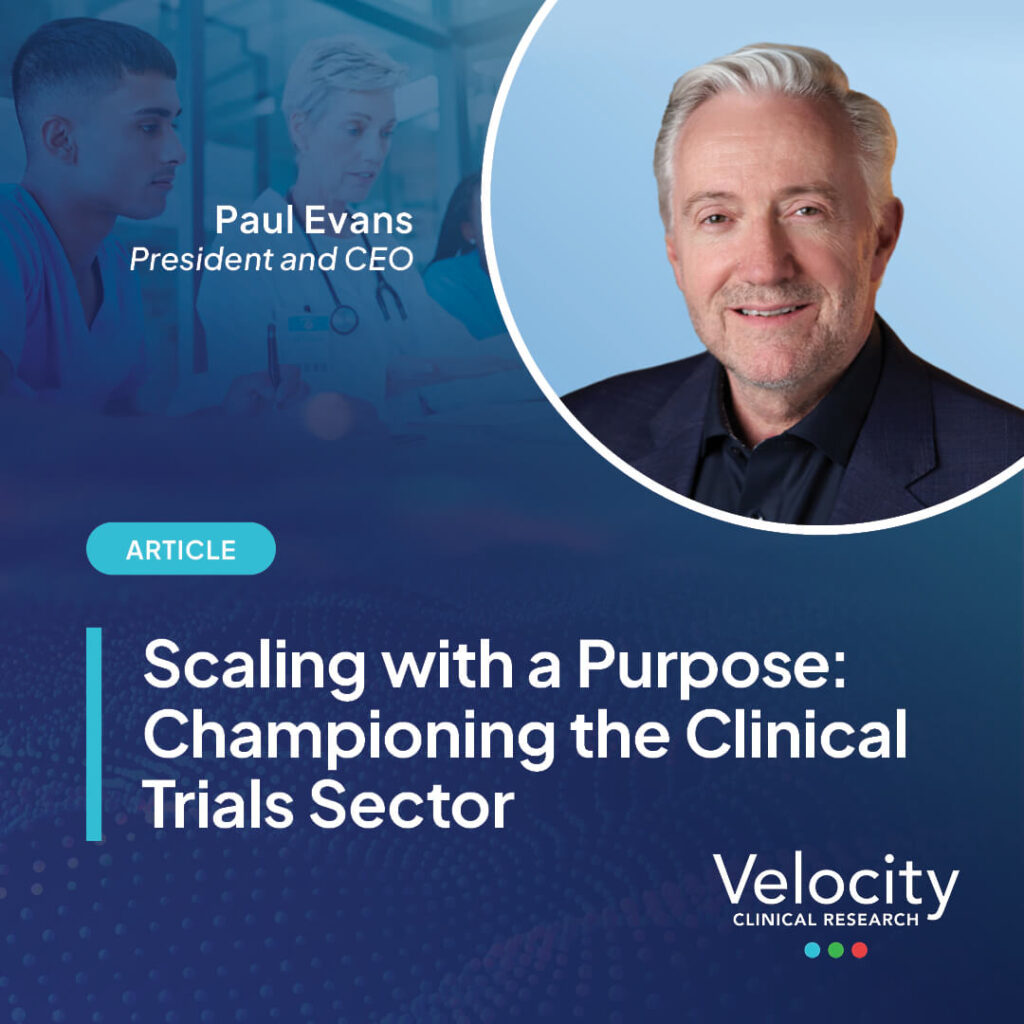At the beginning of September, Velocity Clinical Research topped Business North Carolina’s 2024 Fast 40 list. It was our third time receiving the award, which recognizes the fastest-growing mid-market businesses in the state.
For a clinical trials organization to achieve this level of scale is notable. The clinical trials sector in the US is typically made up of small independent businesses that collectively play an important role in trialing new protocols and aiding drug development. Velocity is among the few exceptions. We’re now the world’s largest integrated network, with almost 100 sites across the US, UK, and Europe, and 220 investigators.
However, that achievement raises an important question: What is the purpose of scale? And what is the responsibility of rapidly growing companies toward our staff, communities, and industries more generally?
The Responsibility of Scale
Our size affords us advantages that the smaller players don’t have. Network organizations that represent multiple sites have more sway to influence industry standards, develop specialist technologies and training resources, and advocate for better practices that benefit staff, participants, CROs, and Sponsors. That creates opportunities and a responsibility to ensure that those opportunities benefit more than just our business.
Recruitment
Clinical trial sites live and die by their ability to recruit patients into trials. They’re often hindered by misconceptions around safety or the idea that trials are for those who have ‘run out’ of other treatment options. Combating these beliefs requires a significant investment in community engagement, outreach, and education — work that can be challenging for smaller teams but one that larger players are resourced to handle.
At Velocity, we have teams that actively engage with local communities through coalition groups, faith organizations, hospital systems, and other trusted community channels. By becoming a visible and active part of the community, we help to build awareness, trust, and understanding around clinical trials. This kind of engagement ensures that local communities are informed about the benefits of participating in trials and understand the processes involved, reducing hesitancy and encouraging participation.
It also tackles the issue of awareness, another common barrier. Many people don’t even realize they may qualify for a trial or how it could benefit them. With the resources to invest in broad community outreach and marketing initiatives, organizations like Velocity can tackle this issue head-on, creating educational campaigns that explain what trials have to offer and the vital role participants play. When more people are informed and interested in trials, recruitment becomes easier for everyone — large and small sites alike.
Inclusivity
These activities don’t just benefit trial sites. They are also key to engaging with communities that have traditionally distrusted healthcare providers and so tend not to enroll at all. Building relationships, awareness, and trust among these groups can encourage participation and support the enrollment of diverse and underrepresented populations. This is vital if we’re to ensure that drug trials are inclusive and deliver results that are representative of the entire population.
Historically, clinical trial sites have been concentrated in urban centers or tied to academic institutions. For smaller businesses and single sites, it makes sense to position themselves in areas with high footfall and a large potential pool of participants. The result is a system that often excludes rural communities, leaving potential participants with choices like whether they should leave their support systems behind to participate in a study. Networks have the resources to expand into these underserved rural areas, increasing access to trials for individuals who might not otherwise have the opportunity to participate and broadening Sponsor and CRO access to diverse patients in the process.
Technological Advancement
Tools like ChatGPT and Claude have made generative artificial intelligence (Gen AI) mainstream and accessible to almost all businesses. However, the development of sector-specific Gen AI solutions is currently focused on highly commercial industries, such as retail and manufacturing.
AI solutions designed specifically for the life sciences sector (rather than retrofitted from other industries) will require development by professionals who understand the unique challenges of our industry. For independent clinical trial sites, this is currently unattainable. However, larger players have the datasets, technical expertise, and financial backing to make tools that address the operational challenges faced by clinical trial sites.
Velocity has fine-tuned large language models (LLMs) to automatically extract medical information, such as conditions, allergies, and medications, and convert them into labeled, structured datasets. This automates the process of collating unstructured data from patient histories into a digital database and enables our AI-driven tools to further automate downstream processes. Our app VISION Recruit, for example, matches potential participants in a site’s database with inclusion and exclusion criteria, ranks candidates based on their eligibility, and contacts them directly, saving site staff time and ensuring all eligible participants are included.
Scaling for a Purpose
At its core, scaling isn’t just about getting bigger — it’s about ensuring that growth benefits everyone. I’m very proud of the Velocity team’s achievements, not least because our approach to scaling is thoughtful and intentional.
Networks like Velocity have a crucial role in shaping our industry. Our scale allows us to drive inclusion, develop specialized tools, advocate for the sector, streamline trials, deliver for our clients, and enhance patient outcomes. By scaling for that purpose, we intend to benefit our industry, not overwhelm it.

